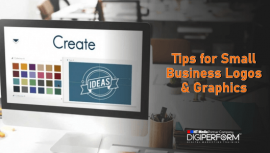Effective and engaging logos and graphics are very effective on websites, flyers, custom stickers, and countless other materials to promote your small business. It used to be that you needed to hire a professional graphic designer in order to make your logo and graphics, which can be a considerable expense for small businesses.
However, these days there are a number of programs that small businesses can use to create their own logo and graphics. Although these tools are fairly easy to use, if you want your logo to work for you, you need to follow appropriate design rules. Here are some top tips to help you create dynamic logos and graphics for your small business.
1. Reflect Your Brand
It’s not enough that your logo and graphics look great, they also need to reflect your brand. It is important that all of the visual elements of your brand, and especially your logo, tell your audience who your brand is. Your customers and potential customers should be able to look at your logo and instantly see who your business is and what you stand for.
When you look at the most successful logo designs, you’ll see that they visually represent the brands’ value and strongly convey these to their audience. For example, Twitter’s logo is modern and progressive, to represent the company’s innovative and progressive form of communication.
The Target logo on the surface level very obviously conveys the name of the company with its target motif. However, on a deeper level, the set of circles also conveys the brand’s values of strength, trust, friendship, and community.
As a first step, you need to know your brand. If you have not already determined your key brand values and brand personality, now is the time to work this out, before you design your logo.
From there, you can work out how to best convey your branding through your logo and other graphics. Brand values and personality should be reflected in every element of the graphics, from the colors to the font.
2. Think About Logos and Taglines
When creating your logo, it is important to have all the relevant elements. All small businesses should have not just a logo but a tagline as well. This helps to reinforce your brand and convince your customers to buy your product. Like your logo, your tagline will speak to your brand and is an extra tool to convey your brand values and personality to your audience.
With modern logo design programs like 99designs, you can easily make a number of different versions of your logo and supplementary graphics with little extra effort. When creating your designs it is a good idea to create a range of graphics, include the logo alone, the logo and tagline together, and the tagline alone.
You can then use the most appropriate of these in your materials and content depending on the situation.
3. Take your Lead from the Big Brands
Just because your business is small, this doesn’t mean you don’t have anything to learn from the world’s biggest brands. Big corporations spend millions of dollars on marketing every year, and the tactics they come up with can often be translated to even the smallest businesses.
Take a look at what the world’s biggest brands do when creating their logo and graphics. You’ll notice that these are generally simple, clear, and impactful. You’ll also note that they observe certain rules when it comes to color, font, proportion, and symmetry, which we’ll cover below.
4. Colors
When designing your logo and graphics for your small business, keep color in mind. Colour plays a huge role in graphics: it can capture attention, as well as going a long way to convey certain values and emotions. For example, blue is commonly used in corporate logos, particularly in the health and financial industries, because it conveys a sense of security and trust.
When designing a logo, try to keep it to two or a maximum of three colors: this will keep your color story more impactful. These should be your brand’s main colors that reflect your brand story. Once you have settled on your brand’s two or three main colors, use them consistently across all of your graphics to build your business’ brand.
5. Fonts
Fonts also play a strong role in designing graphics for your small business. Like other elements, certain fonts can convey values and emotions that can go a long way to help to sell your product if used well. Poor fonts, on the other hand, can damage your sales, so be sure to choose strong fonts that reflect your key values.
The best designs often use two different fonts, although a single font can also be effective. Choose two fonts that are different but look good together, and use them in different parts of the same graphic. Avoid using more than two fonts, however, as it can be messy and overwhelming.
6. Proportion and Symmetry
Proportion and symmetry are also important elements to consider in design. Proportion is very impactful on logos and other types of graphics: keeping all parts of the design in proper proportion makes the design more aesthetically pleasing and therefore more eye-catching (in a good way).
Equally, symmetry is critical in logo design. If you look at the world’s most famous and stunning logos, you’ll notice that many of them are symmetrical at least in terms of their overall shape.
This is because symmetry is more naturally pleasing to the human eye, meaning your customers will respond better to your logo. By applying these techniques and tactics, you will be able to create a strong logo that will promote your business, build your brand, and help to grow your small business.






